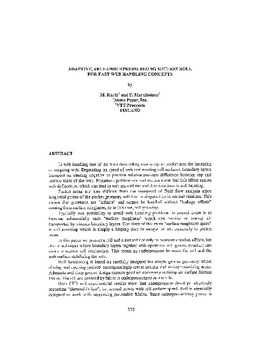| dc.contributor.author | Kurki, M. | |
| dc.contributor.author | Martihainen, P. | |
| dc.contributor.other | International Conference on Web Handling (2005) | |
| dc.date.accessioned | 2019-11-08T22:56:51Z | |
| dc.date.available | 2019-11-08T22:56:51Z | |
| dc.date.issued | 2005-06 | |
| dc.identifier | oksd_icwh_2005_kurki | |
| dc.identifier.citation | Kurki, M., & Martihainen, P. (2005, June). Adaptive, self-underpressurizing suction roll for fast web handling concepts. Paper presented at the Eighth International Conference on Web Handling (IWEB), Stillwater, OK. | |
| dc.identifier.uri | https://hdl.handle.net/11244/321883 | |
| dc.description.abstract | In web handling one of the most demanding area is nip or pocket area for incoming or outgoing web. Depending on speed of web and rotating roll surfaces, boundary layers transport air causing negative or positive relative pressure difference between top and bottom sides of the web. Numerous publications and studies show that this effect causes web deflections, which can lead to web instabilities and deteriorations in web handing. | |
| dc.description.abstract | Pocket areas are also difficult from the viewpoint of fluid flow analysis since tangential points of the pocket geometry will lead to singularities in nom1al situation. This means that pressures are "infinite" and cannot be handled without "leakage effects" coming from surface roughness, or in this case, roll grooving. | |
| dc.description.abstract | Typically one possibility to avoid web handling problems in pocket areas is to increase substantially such "surface roughness" which can receive or convey air transported by viscous boundary layers. One form of this extra "surface roughness space'' is roll grooving which is simply a helping duct or escape for air, especially in pocket areas. | |
| dc.description.abstract | In this paper we present a roll and a method not only to overcome pocket effects, but also a technique where boundary layers together with optimized roll groove structure can create a suction roll mechanism. This forms an underpressure between the roll and the web surface stabilizing the web. | |
| dc.description.abstract | Roll functioning is based on carefully designed but simple groove geometry where closing and opening pockets correspondingly create sealing and underpressurizing areas. Adequate and deep groove design ensures good air conveying utilizing air-surface friction forces. The roll arc covered by fabric is underpressurized as a whole. | |
| dc.description.abstract | Both CFD and experimental results show that underpressure develops adaptively according "Bernoulli's law" i.e. second power with roll surface speed. Roll is especially designed to work with supporting permeable fabrics. Since underpressurizing power is coming from rotational speed and boundary layers, no external vacuum or suction devices are needed. Since whole wrap area is underpressurized from closing nip to opening nip, roll performance is ideal for such web handling situations where excessive web tensioning and web straining should be avoided. | |
| dc.description.abstract | In paper making industry with continuously increasing web speeds, more cost-effective web handling systems are needed. There, the web supporting is in essential position. With permeable, supporting paper making fabrics, web handling possibilities can be improved significantly when roll pocket effects can be controlled efficiently. | |
| dc.format | application/pdf | |
| dc.language | en_US | |
| dc.publisher | Oklahoma State University | |
| dc.rights | In the Oklahoma State University Library's institutional repository this paper is made available through the open access principles and the terms of agreement/consent between the author(s) and the publisher. The permission policy on the use, reproduction or distribution of the article falls under fair use for educational, scholarship, and research purposes. Contact Digital Resources and Discovery Services at lib-dls@okstate.edu or 405-744-9161 for further information. | |
| dc.title | Adaptive, self-underpressurizing suction roll for fast web handling concepts | |
| osu.filename | oksd_icwh_2005_kurki.pdf | |
| dc.type.genre | Conference proceedings | |
| dc.type.material | Text | |
